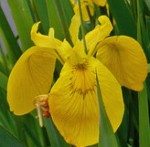 Also called water flag, this herbaceous perennial is a beardless rhizomatous iris native to the wetlands of Europe, western Asia and northwest Africa where it forms large colonies. It is a member of the iris family, Iridaceae, that also includes crocosmia, gladiolus, and Mexican shell flower. Plants grow 3-5′ tall and have gray-green sword like leaves with prominent mid-rib and bright yellow flowers. Four to twelve flowers appear on branched stalks in late spring to early summmer. Each flower is about 3-4″ across and has 3 upright petals and 3 petaloid sepals that droop downward and have darker yellow zone and brown or violet veining. The fruit is a several seeded dry capsule that is attractive in dried arrangements.
Also called water flag, this herbaceous perennial is a beardless rhizomatous iris native to the wetlands of Europe, western Asia and northwest Africa where it forms large colonies. It is a member of the iris family, Iridaceae, that also includes crocosmia, gladiolus, and Mexican shell flower. Plants grow 3-5′ tall and have gray-green sword like leaves with prominent mid-rib and bright yellow flowers. Four to twelve flowers appear on branched stalks in late spring to early summmer. Each flower is about 3-4″ across and has 3 upright petals and 3 petaloid sepals that droop downward and have darker yellow zone and brown or violet veining. The fruit is a several seeded dry capsule that is attractive in dried arrangements.
The Hebrew word shushan has been translated by lily but in at least one verses some scholars think an iris is meant. There are 50 or more kinds of Iris in the Holy Land but yellow flag seems most likely because it grows in wet to moist soils while other iris native to the area inhabit dry hillsides.
Hosea 14.5 (NIV) God promises to restore a repentant Israel.
“I will be like the dew to Israel; he will blossom like a lily. Like a cedar of Lebanon he will send down his roots;”
Yellow flag does well in USDA Hardiness Zones 4-9 either in standing water in full sun ar wet, acidic soil with afternoon shade. It is less vigorous in moist soil and, therefore, less likely to become invasive. Propagation is by seeds and rhizomes. Plants are healthy and have no significant pests or diseases. Yellow flag has been used in sewage treatment because it can remove heavy metals from the soil. Historically, preparations from the roots have been used as snuff, the flowers for dye, and the rhizomes as a laxative. The flowers are lovely in bouquets and were probably the model for the fleur de lis, the heraldic emblem of French kings in the 12th century.
The genus name, Iris, honors the Greek goddess of the rainbow. The specific epithet, pseudacornus, comes from the Greek prefix pseudo meaning false, and a the name of the species Acornus, a grass like unrelated plant that has asimilar leaf.
Bright yellow flowers (3-4” across), with a darker yellow zone and brown or violet veining on each fall, bloom in late spring to early summer on rigid, upright, branched stalks. Each flower stalk bears 4-12 flowers. Flowers give way to large seed pods. Sword-shaped, gray green leaves (1 1/8” wide). Plant roots have been used in the past for a variety of purposes including medical treatments, dyes, inks, and snuff. Plant seeds have been used as a coffee substitute (no caffeine however).
yellow iris, or water flag, is a species of flowering plant in the family Iridaceae. It is native to Europe, western Asia and northwest Africa. Its specific epithet pseudacorus means “false acorus”, referring to the similarity of its leaves to those of Acorus calamus (sweet flag), as they have a prominently veined mid-rib and sword-like shape. However, the two plants are not closely related.
Crocosmia, gladiolus, freesia, Mexican shell flower
Europe to western Siberia, Caucasus, northern Africa
average, medium to wet soils in full sun to part shade. Best performance is in acidic, saturated, moisture-retentive soils. Plants thrive in standing water (to 12” deep) where they prefer full sun. Plants grown in garden soils prefer some afternoon shade. Plants will naturalize easily by spreading rhizomes and self-seeding to form large colonies, sometimes to the point of being considered weedy and aggressive
This herbaceous flowering perennial plant grows to 100–150 cm (39–59 in), or a rare 2 m (6 ft 7 in) tall, with erect leaves up to 90 cm (35 in) long and 3 cm (1.2 in) broad. The flowers are bright yellow, 7–10 cm (2.8–3.9 in) across, with the typical iris form. The fruit is a dry capsule 4–7 cm (1.6–2.8 in) long, containing numerous pale brown seeds.
I. pseudacorus grows best in very wet conditions, and is common in wetlands, where it tolerates submersion, low pH, and anoxic soils. The plant spreads quickly, by both rhizome and water-dispersed seed. It fills a similar niche to that of Typha and often grows with it, though usually in shallower water. While it is primarily an aquatic or marginal plant, the rhizomes can survive prolonged dry conditions.
for moist boggy areas of water gardens including standing water. It is also effective in moist meadows, along ponds or in other high moisture areas of the landscape. Plants will perform well in borders as long as soil moisture requirements can be met. Yellow flag should not be planted along streams or ponds or lakes where it can spread into natural waterways and wetland areas may occur. Seed pods are valued for dried flower arrangements.